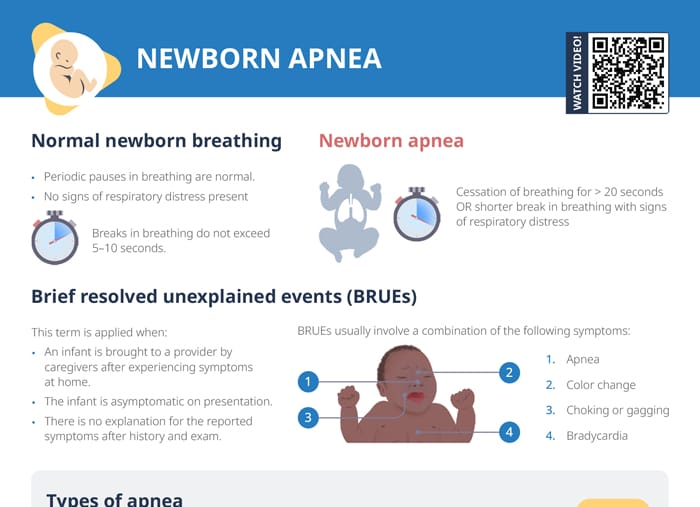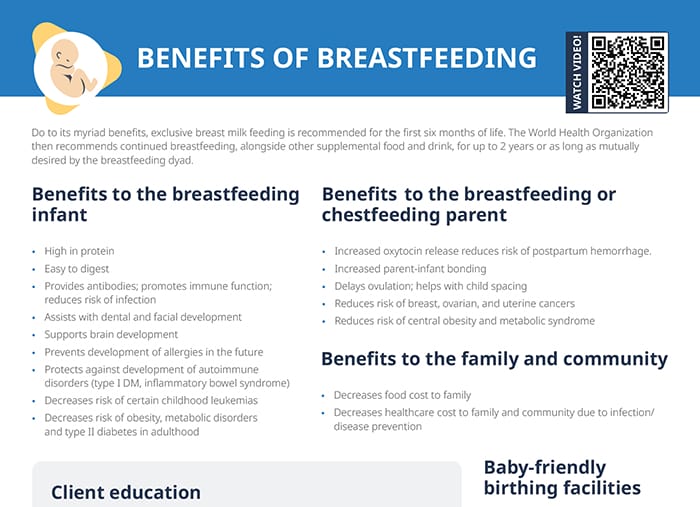The physical benefits of breastfeeding
The main physical benefits of breastfeeding are:
- Immune benefits could be most pronounced due to direct transfer
- Milk is at correct temperature
- Helps in uterine contraction and postpartum recovery
- Breast milk is:
- High in protein
- Easy to digest
- Provides antibodies; promotes immune function; reduces risk of infection
- Assists with dental and facial development
- Supports brain development
- Prevents development of allergies in the future
- Protects against development of autoimmune disorders (type I DM, inflammatory bowel syndrome)
- Decreases risk of certain childhood leukemias
- Decreases risk of obesity, metabolic disorders and type II diabetes in adulthood
- Increased oxytocin release reduces risk of postpartum hemorrhage.
- Delays ovulation; helps with child spacing
- Reduces risk of breast, ovarian, and uterine cancers
- Reduces risk of central obesity and metabolic syndrome
Psychological benefits of breastfeeding
- Increased bonding between breastfeeding dyad
- Comfort and security for the child
Tip: Whether by bottle or breast, feeding is an important time for connection and bonding. Encourage clients to make eye contact and talk to the baby while feeding.
Benefits of extended breastfeeding
Extended breastfeeding refers to continuing to breastfeed the infant past the age of one year.
Generally, it is said that the longer a baby is breastfed, the longer they benefit from the immune and developmental supportive effects. It is important to note that the duration of breastfeeding is individual and parents should never be pressured to continue or cease breastfeeding unless there are medical reasons.
The longer-term breastfeeding also has an impact on the family and the community: It decreases food cost to the family and decreases healthcare cost to family and community due to infection/disease prevention.
Benefits of pumping
Pumping breast milk and bottle feeding the infant offers greater flexibility. Others can take over feeding the baby, allowing the mother to rest or get other things done. Pumped milk can be stored for later use and mothers who return to work can continue breastfeeding.
Also, pumping and bottle feeding allows for more exact monitoring of the milk volume the baby consumes.
How to support breastfeeding clients
Guidelines for supporting successful breastfeeding initiation:
- Teach families about the benefits of breastfeeding.
- Initiate breastfeeding within one hour of birth.
- Facilitate rooming-in, and frequent skin-to-skin contact
- Provide education and support to establish and maintain lactation.
- Encourage breastfeeding on demand.
- Do not offer food or drink other than breast milk, unless medically indicated.
- Do not offer pacifiers or artificial nipples to breastfeeding infants.
- Connect breastfeeding families with support groups and other local resources.
Families are more likely to initiate and sustain breastfeeding when they receive timely education, support and encouragement. Teach proper latching-on technique. Achieving a deep latch promotes adequate milk transfer and prevents nipple tissue damage.
Demonstrate and support clients to try a variety of breastfeeding positions. Emphasize positions that meet the specific needs of the newborn period. Explain that the ideal feeding position may change as the baby grows.
Related videos
How to bottle feed a baby
Bottle preparation
- Sterilize bottles and nipples; avoid re-contamination during storage and handling.
- Wash hands and disinfect the work area before preparing a bottle.
- If using infant formula, check the expiration date and follow preparation instructions on packaging carefully.
- Use a clean water source or sterilize water if mixing powdered infant formula.
- Check the temperature of warmed breast milk or formula on the inside of the wrist before feeding to avoid burning the baby’s mouth.
Bottle feeding
- Offer the bottle when the baby shows signs of hunger.
- Hold the baby in a semi-upright position with the head supported.
- Stroke the upper lip gently with the nipple and allow the baby to draw it into their mouth.
- Hold the bottle at a slight tilt, so milk fills the nipple but does not flow freely unless the baby sucks.
- Stop feeding when the baby shows signs of fullness, even if the bottle is not empty. Discard the leftover formula.
- Never prop a baby with a bottle in their mouth or leave them unattended while feeding; can lead to choking and future dental issues.
Feeding frequency
The quantity and frequency of feeding will change over time as the infant grows. Feeding patterns may vary from one infant to another.
Whether feeding by bottle or breast, feeding should be done on-demand following the baby’s hunger and satiety cues.
Average frequency of feeding:
- First 2 weeks: every 2–3 hours
- From 2 weeks to 1 month: every 3–4 hours
- After 1 month: every 3–6 hours
How to store breast milk
Use leftover breast milk within 2 hours after the baby is finished feeding.
| Room temperature | Refrigerator | Freezer | |
| Formula | Up to 2 hours; 1 hour after feeding | Up to 1 day | Does not require freezing |
| Freshly pumped breast milk | Up to 4 hours | Up to 4 days | Best up to 6 months (up to 12 months acceptable) |
| Thawed breastmilk | 1–2 hours | Up to 1 day | Never refreeze |

